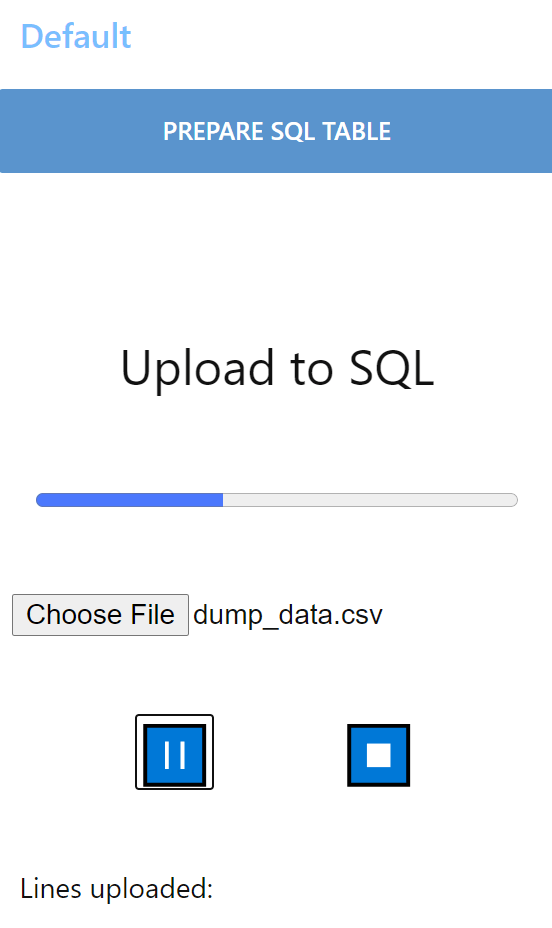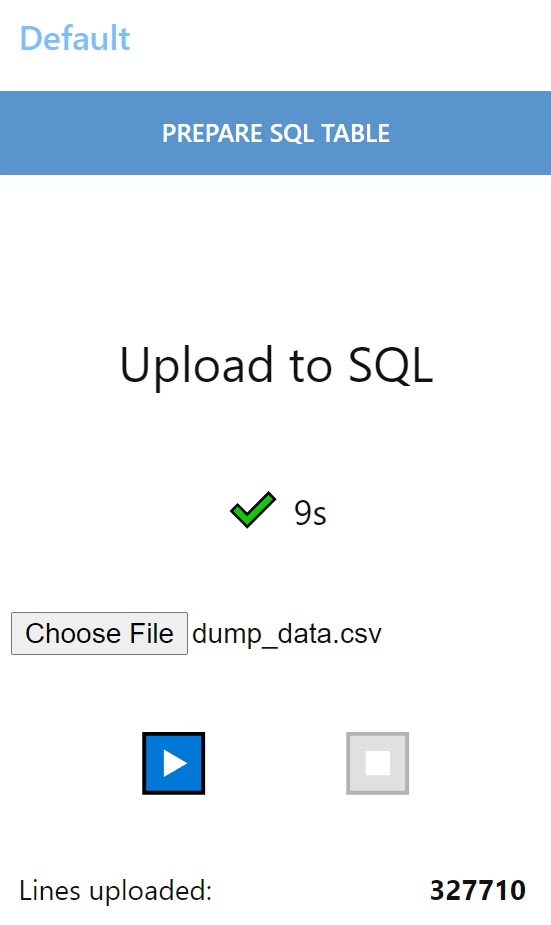|
[ |
|
{ |
|
"id": "e6ec0f0a.388198", |
|
"type": "chunks-to-lines", |
|
"z": "d9a661f4.ef966", |
|
"name": "", |
|
"nbLines": "4096", |
|
"linesFormat": "csv", |
|
"decoder": "UTF-8", |
|
"x": 280, |
|
"y": 940, |
|
"wires": [ |
|
[ |
|
"436dce51.065f6" |
|
] |
|
] |
|
}, |
|
{ |
|
"id": "a2a16dc6.fbd32", |
|
"type": "function", |
|
"z": "d9a661f4.ef966", |
|
"name": "Ready for next lines", |
|
"func": "return [\n msg.complete ? msg : null,\n { tick: true },\n];\n", |
|
"outputs": 2, |
|
"noerr": 0, |
|
"initialize": "", |
|
"finalize": "", |
|
"libs": [], |
|
"x": 940, |
|
"y": 880, |
|
"wires": [ |
|
[ |
|
"87fbc09b.6deeb", |
|
"35615002.196b78" |
|
], |
|
[ |
|
"e6ec0f0a.388198" |
|
] |
|
] |
|
}, |
|
{ |
|
"id": "436dce51.065f6", |
|
"type": "csv", |
|
"z": "d9a661f4.ef966", |
|
"name": "", |
|
"sep": ",", |
|
"hdrin": true, |
|
"hdrout": "none", |
|
"multi": "mult", |
|
"ret": "\\n", |
|
"temp": "", |
|
"skip": "0", |
|
"strings": false, |
|
"include_empty_strings": "", |
|
"include_null_values": "", |
|
"x": 430, |
|
"y": 940, |
|
"wires": [ |
|
[ |
|
"4127dd44.2d49d4" |
|
] |
|
] |
|
}, |
|
{ |
|
"id": "4127dd44.2d49d4", |
|
"type": "function", |
|
"z": "d9a661f4.ef966", |
|
"name": "Format SQL", |
|
"func": "if (msg.payload && msg.payload.length > 0) {\n let payload = 'INSERT INTO your_table(time, sensor, data) VALUES ';\n \n for (const line of msg.payload) {\n payload += `('${line.time}', '${line.sensor}', '${line.data}'),`;\n }\n \n msg.payload = payload.slice(0, - 1) + ';';\n}\nreturn msg;\n", |
|
"outputs": 1, |
|
"noerr": 0, |
|
"initialize": "", |
|
"finalize": "", |
|
"libs": [], |
|
"x": 570, |
|
"y": 940, |
|
"wires": [ |
|
[ |
|
"65c0779b0f924c8b" |
|
] |
|
] |
|
}, |
|
{ |
|
"id": "d5504079.651a68", |
|
"type": "comment", |
|
"z": "d9a661f4.ef966", |
|
"name": "Upload to SQL", |
|
"info": "", |
|
"x": 120, |
|
"y": 780, |
|
"wires": [] |
|
}, |
|
{ |
|
"id": "715380a8.42ec7", |
|
"type": "debug", |
|
"z": "d9a661f4.ef966", |
|
"name": "", |
|
"active": true, |
|
"tosidebar": true, |
|
"console": false, |
|
"tostatus": false, |
|
"complete": "true", |
|
"targetType": "full", |
|
"statusVal": "", |
|
"statusType": "auto", |
|
"x": 530, |
|
"y": 840, |
|
"wires": [] |
|
}, |
|
{ |
|
"id": "87fbc09b.6deeb", |
|
"type": "debug", |
|
"z": "d9a661f4.ef966", |
|
"name": "Done", |
|
"active": true, |
|
"tosidebar": true, |
|
"console": false, |
|
"tostatus": true, |
|
"complete": "true", |
|
"targetType": "full", |
|
"statusVal": "_parts.lines", |
|
"statusType": "msg", |
|
"x": 1170, |
|
"y": 940, |
|
"wires": [] |
|
}, |
|
{ |
|
"id": "4b31cec2.dad2c8", |
|
"type": "ui_upload", |
|
"z": "d9a661f4.ef966", |
|
"group": "593aaad02ba9e607", |
|
"title": "Generic upload to SQL", |
|
"name": "uploadSql", |
|
"order": 3, |
|
"width": 6, |
|
"height": 6, |
|
"chunk": "256", |
|
"transfer": "binary", |
|
"x": 100, |
|
"y": 940, |
|
"wires": [ |
|
[ |
|
"e6ec0f0a.388198" |
|
] |
|
] |
|
}, |
|
{ |
|
"id": "35615002.196b78", |
|
"type": "ui_text", |
|
"z": "d9a661f4.ef966", |
|
"group": "6426525.5bfe1ac", |
|
"order": 3, |
|
"width": 0, |
|
"height": 0, |
|
"name": "", |
|
"label": "Lines uploaded:", |
|
"format": "{{msg._parts.lines}}", |
|
"layout": "row-spread", |
|
"x": 1200, |
|
"y": 880, |
|
"wires": [] |
|
}, |
|
{ |
|
"id": "65d2e9d6.5ca5", |
|
"type": "ui_button", |
|
"z": "d9a661f4.ef966", |
|
"name": "", |
|
"group": "593aaad02ba9e607", |
|
"order": 1, |
|
"width": 0, |
|
"height": 0, |
|
"passthru": false, |
|
"label": "Prepare generic SQL table", |
|
"tooltip": "", |
|
"color": "", |
|
"bgcolor": "", |
|
"icon": "", |
|
"payload": "", |
|
"payloadType": "str", |
|
"topic": "", |
|
"topicType": "str", |
|
"x": 160, |
|
"y": 840, |
|
"wires": [ |
|
[ |
|
"6b76c340a580b0a4" |
|
] |
|
] |
|
}, |
|
{ |
|
"id": "6b76c340a580b0a4", |
|
"type": "postgresql", |
|
"z": "d9a661f4.ef966", |
|
"name": "", |
|
"query": "DROP TABLE IF EXISTS your_table;\nCREATE TABLE your_table (\n\tid\t\tSERIAL\tNOT NULL,\n\ttime\tTIMESTAMP WITH TIME ZONE\tNOT NULL,\n\tsensor\tTEXT,\n\tdata\tJSONB\n);\n\nSELECT create_hypertable('your_table', 'time');\nCREATE INDEX IF NOT EXISTS index_sensor ON your_table(\"sensor\");\n", |
|
"postgreSQLConfig": "20ae1e52d1eef983", |
|
"split": false, |
|
"rowsPerMsg": 1, |
|
"outputs": 1, |
|
"x": 370, |
|
"y": 840, |
|
"wires": [ |
|
[ |
|
"715380a8.42ec7" |
|
] |
|
] |
|
}, |
|
{ |
|
"id": "65c0779b0f924c8b", |
|
"type": "postgresql", |
|
"z": "d9a661f4.ef966", |
|
"name": "", |
|
"query": "{{{ msg.payload }}}", |
|
"postgreSQLConfig": "20ae1e52d1eef983", |
|
"split": false, |
|
"rowsPerMsg": 1, |
|
"outputs": 1, |
|
"x": 730, |
|
"y": 940, |
|
"wires": [ |
|
[ |
|
"a2a16dc6.fbd32" |
|
] |
|
] |
|
}, |
|
{ |
|
"id": "593aaad02ba9e607", |
|
"type": "ui_group", |
|
"name": "Default", |
|
"tab": "5f17e3a3.4c85ac", |
|
"order": 1, |
|
"disp": true, |
|
"width": "6", |
|
"collapse": false |
|
}, |
|
{ |
|
"id": "6426525.5bfe1ac", |
|
"type": "ui_group", |
|
"name": "Default", |
|
"tab": "cb135bc2.cc3d9", |
|
"order": 1, |
|
"disp": true, |
|
"width": "6", |
|
"collapse": true |
|
}, |
|
{ |
|
"id": "20ae1e52d1eef983", |
|
"type": "postgreSQLConfig", |
|
"name": "admin@timescale:5432/iot", |
|
"host": "timescale", |
|
"hostFieldType": "str", |
|
"port": "5432", |
|
"portFieldType": "num", |
|
"database": "iot", |
|
"databaseFieldType": "str", |
|
"ssl": "false", |
|
"sslFieldType": "bool", |
|
"max": "10", |
|
"maxFieldType": "num", |
|
"min": "1", |
|
"minFieldType": "num", |
|
"idle": "1000", |
|
"idleFieldType": "num", |
|
"connectionTimeout": "10000", |
|
"connectionTimeoutFieldType": "num", |
|
"user": "admin", |
|
"userFieldType": "str", |
|
"password": "RTffY87xVqGA", |
|
"passwordFieldType": "str" |
|
}, |
|
{ |
|
"id": "5f17e3a3.4c85ac", |
|
"type": "ui_tab", |
|
"name": "Generic demo", |
|
"icon": "dashboard", |
|
"disabled": false, |
|
"hidden": false |
|
}, |
|
{ |
|
"id": "cb135bc2.cc3d9", |
|
"type": "ui_tab", |
|
"name": "Anomaly", |
|
"icon": "dashboard", |
|
"disabled": false, |
|
"hidden": false |
|
} |
|
] |


